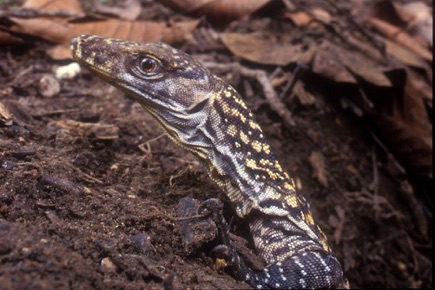Komodo dragons


Komodo dragons




Back to the
“Conservation Genetics” page
Back to the
“LANE”
introduction page

FACTS
Species:
‣Varanus komodoensis
Locations:
‣Islands of Komodo, Rinca, Flores, and Gili Motang (all in Indonesia)

PUBLICATIONS
‣Molecular Ecology Resources, 11: 550-556 (2011)

Related publications from our group on population genetics
‣Check the main Conservation Genetics page

THE ITALIAN TEAM
The Komodo dragon project has been initiated in the early 2000’s by Claudio Ciofi (University of Florence, Italy).
Claudio Ciofi

PEOPLE INVOLVED
FROM MICHEL
MILINKOVITCH’S LAB
‣Michel

MAIN COLLABORATORS IN INDONESIA
Indonesian Institute of Science (LIPI), Cibinong
The main people involved are:
✓Sri Sulandari
✓Moch S. A. Zein




Conservation genetics and captive breeding program of the Komodo dragon
A main goal of breeding endangered species in captivity is to plan mating events across zoological gardens in order to maintain genetically viable populations. Zoo collections are therefore managed jointly under the goal of a species’ long-term conservation for captive individuals that may eventually be used for reintroduction programs. Loss of genetic variation in small captive population may result in a lower long-term individual fitness. Inbreeding depression, the reduction of fecundity and viability in progeny of mating between close genetic relatives, has been extensively documented in captivity. Because genetic diversity of a captive population is represented by the gene pool of founder individuals, captive breeding programs try to minimize the loss of founders’ genetic variation. This is most effectively accomplished under conditions that allow intensive management and in populations with completely known pedigrees. If this is the case, decisions can then be made about breeding pairs, frequency, and time of mating events. Unfortunately, few captive populations have had the benefit of genetic management throughout their history. When either genetic relatedness among individuals or the origin of a specific founder can not be assessed because of poor or missing pedigree data, molecular genetics techniques become an invaluable tool to infer kinship and identify provenience of individuals, therefore allowing informed decision to be made on how to best manage captive groups (see our web pages on Española Galápagos giant tortoises and Jamaican boas).
Several endangered tropical species bred in captivity are represented by founders kept in their country of origin. A number of such countries, Indonesia in particular, have recently banned the export of material for genetic analysis, and are instead encouraging foreign donors to help develop infrastructure and expertise for conducting genetic studies in local academic or governmental institutions. Therefore, the implementation of international breeding programs may need the establishment of facilities in the country of origin of the species for which a captive management plan has to be developed.
Aim of our program
The Komodo dragon, Varanus komodoensis, is the world’s largest species of monitor lizard, now confined to five islands in southeastern Indonesia. Wild populations are threatened by habitat encroachment and depletion of prey species. To date, more than 200 individuals are kept in 42 zoological gardens worldwide, including Europe, the USA, Canada, Japan, Australia, and Indonesia, the latter holding most of the founders. For several individuals that hatched in captivity, parentage analysis using pedigree information has been hampered by absence of detailed records. Mating events have not been properly monitored, particularly for Indonesian founders, and inconsistencies exist between European and North American studbooks. Moreover, in lizards, female reproductive tracts may retain viable sperm for as long as two months, and in Indonesia, where animals have been kept in communal enclosures, a females’ first mate may father hatchlings in subsequent clutches. Concurrent multiple paternity may also occur, rendering assessment of parental relationships more difficult.
Recently, Claudio Ciofi (initiator of the project, University of Florence, Italy) joined force with Michel Milinkovitch (University of Geneva, Switzerland) for the development of molecular markers specific to the Komodo dragon. These tolls will allow the research team to clarify unknown relationships among captive Komodo dragons, estimate inbreeding coefficients and founder representation and provide information for appropriate pairings, in order to maintain genetic variation in the captive stock. Genetic analyses of key individuals from the European and North American captive stock are being carried out at the University of Florence (Italy) and the University of Geneva (Switzerland), whereas analysis of samples from Indonesian founders and other first generation individuals will have to be conducted in Indonesia. Thanks to a recent Memorandum of Agreement with the Indonesian Institute of Science (LIPI), DNA samples from Indonesian captive Komodo dragons can be analysed at the genetic laboratory of the LIPI Center for Biological Research located in Cibinong, about 50 km south of the capital city of Jakarta. The laboratory has basic equipment for genetic analysis.
This program will not only provide valuable information to the international zoo community, but will also train Indonesian technical staff in genetic analysis applied to wildlife conservation. The Italian and Swiss teams are performing the analysis of the raw data for investigating population structure, conservation genetics, and captive breeding programs.
Results
We constructed a partial genomic library enriched for dinucleotide repeats and characterized microsatellite loci for the Komodo monitor (Varanus komodoensis). We tested these markers for polymorphism using 69 individuals from three island populations and evaluated the resolving power of the entire panel of loci by conducting (1) a preliminary assignment test to determine population(s) of origin and (2) a parentage analysis for 43 captive Komodo monitors. This panel of polymorphic loci proved useful for both purposes and thus can be exploited for fine-scale population genetic analyses and as part of international captive breeding programs directed at maintaining genetically viable ex-situ populations and reintroductions.


Left; Claudio Ciofi capturing a young Komodo dragon for blood sampling. Right; a baby Komodo Dragon hatching from its nest.
Reference
✓Ciofi C., Tzika A.C., Natali C., Watts P.C., Sulandari S., Zein M.S.A. & M. C. Milinkovitch
Development of a multiplex PCR assay for fine-scale population genetic analysis of the Komodo monitor Varanus komodoensis based on 18 polymorphic microsatellite loci
Molecular Ecology Resources 11, 550–556 (2011).
